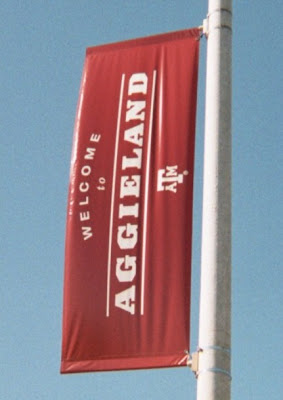In February, I visited
Texas A&M University in College Station (see
here for background on my trip). A&M, in southeast Texas, is almost diametrically apart from where I am at Texas Tech, in the northwest portion of the state.
Upon my return, Dinah Harriger, who did her undergraduate work at A&M and is now a graduate student in Texas Tech's highly regarded
Marriage and Family Therapy program, assisted me in identifying the campus landmarks in the photos I took (it took a little while for us to coordinate our schedules, hence the delay). She also drew my attention to online information about these landmarks.


In addition to
Aggie tradition, A&M is also rich on welcoming signs, as seen in the first two photos. Shown above is the Aggieland water tower, whereas to the right is one of the banners gracing the edge of campus. You'll see plenty of maroon and grey if you visit Texas A&M!
Immediately below this text is a wide shot of the Simpson Drill Field, with some academic buildings in the background. This document from the Brazos County Historical Commission provides a
detailed history of the Drill Field and A&M's role in military training (see the next-to-last paragraph on the BCHC page). The Drill Field is somewhat reminicent of Ohio State University's
Oval and the University of Virginia's
Lawn.


Just off the Drill Field is the Albritton Bell Tower. For an evening shot of the Tower and some physical details about it, check
here.
The Albritton Bell Tower, erected in 1984, has also been the site for a
solemn tribute to the 12 people who died in the 1999 bonfire collapse.
The next three photos down are from the athletic part of campus.
Kyle Field is one of college football's most celebrated venues, with its triple-deck configuration, 12th Man tradition of students standing the whole game (and of couples kissing after every Aggie score), and walk-on
kick-off coverage team for A&M (a practice that has been modified by successive Aggie coaches).

As with other large university campuses in Texas, A&M is not always very pedestrian-friendly, with some kind of major thoroughfare bisecting Kyle Field from the adjacent part of campus. Shown below is the underground tunnel one must walk under, to go to or from Kyle Field. There are signs warning bicyclists to yield to pedestrians. Thinking that there must be a reason for these signs, as I walked under the tunnel, I kept looking around in all directions in case any would-be Lance Armstrongs might roar past me.

On the other side of the tunnel from Kyle Field is Reed Arena (below), one of the Big 12 conference's newest basketball venues. Inside, Reed is similar to Texas Tech's
United Spirit Arena, in that both have two seating decks. The difference is that the USA is double-decked on all four sides, whereas Reed's upper deck only
covers three sides, with the remaining side (behind one of the baskets) an open wall.

Lastly, I always make it a point to get to the "college town" area adjacent to a given campus. On the University Drive side of campus, one finds a mixture of quaint store structures and modern-day franchises such as Domino's Pizza, Potbelly Sandwiches, and Starbucks Coffee (shown below).

I hope my fellow Red Raiders at Texas Tech don't hold this against me, but I found Texas A&M a nice campus to visit!












